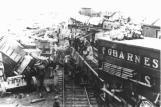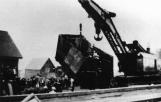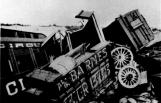1
Prior to the invention of the radio, television, or movies the most popular form of entertainment was the traveling circus. People would eagerly await the coming of the circus to town when they could see all the amazing performances and unusual animals. Traditionally circuses had traveled from town to town in large caravans. However, the growth of the railways had allowed circuses to stage much larger shows that could quickly be dismantled and shipped by special circus trains to another town hundreds of miles away. These trains typically were loaded at night after the final performance and traveled by night to arrive at the next town the following morning to begin to set up the tents. One of these traveling circus shows was the Al G. Barnes five ring animal circus. On Saturday July 19th, 1930 the circus finished its final performance in Newcastle N.B. The tents were taken down, loaded onto the train, and the circus departed for Charlottetown, P.E.I. at 4:25 a.m Sunday morning. The train consisted of the locomotive, followed by 10 stock cars for the animals, then 11 flat cars used to carry the circus wagons, next were 8 passenger/sleeping cars, and finally the caboose. At 6:55 a.m. car 18, a flat car, suddenly derailed causing the other eight cars behind it to derail and pile up together in a zigzag pattern. The accident occurred only 19 miles outside of Moncton in front of the Canaan Station. While no animals were injured 3 men, who had chosen to sleep out on the flat cars because they wanted to enjoy the cool night air rather than sleep in the humid sleeping cars, were instantly killed. 17 others were badly hurt and had to be taken to hospital, one man eventually died in hospital from his injuries. News of the accident quickly spread and it soon seemed that everyone with access to an automobile from the Moncton area was at the wreck site to observe the disaster. A relief train was quickly dispatched from Moncton to transport the injured to hospital while at the same time cranes were dispatched to repair the 200 yards of track that had been torn up by the derailed train. The wreck site was cleared and the salvageable cars and equipment continued on to Moncton. The circus suffered the loss of a great deal of equipment including the loss of 23 circus wagons. Every hotel room in the city was soon filled with stranded circus performers. A later inquest determined that the wreck was an accident caused by a faulty arch-bar which was thought to have derailed the train. No blame was assigned because of the accident. The funeral procession down Main Street for the four men was one of the largest ever in the city; it included members of the circus, the mayor of the city and other dignitaries. The night before on July 22nd the circus put on a show to thank the kind citizens of Moncton who had opened their doors to the performers. Manager of the circus Mr. S. Cronin gave an emotional speech during the show where he thanked the kind citizens of Moncton. The following day the circus packed up and left by train to perform in Nova Scotia.
2
Circus Wreck
20 July 1930
Canaan, New Brunswick, Canada
 Credits:
Credits:
New Brunswick Railway Museum
3
Circus Wreck
20 July 1930
Canaan, New Brunswick, Canada
 Credits:
Credits:
New Brunswick Railway Museum
4
Circus Wreck
20 July 1930
Canaan, New Brunswick, Canada
 Credits:
Credits:
New Brunswick Railway Museum
5
Circus Wreck
20 July 1930
Canaan, New Brunswick, Canada
 Credits:
Credits:
New Brunswick Railway Museum
6
Circus Wreck
20 July 1930
Canaan, New Brunswick, Canada
 Credits:
Credits:
New Brunswick Railway Museum
7
Circus Wreck
20 July 1930
Canaan, New Brunswick, Canada
 Credits:
Credits:
New Brunswick Railway Museum